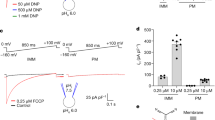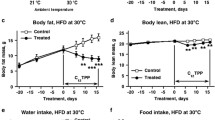Abstract
The protonmotive force (Δp) across the mitochondrial inner membrane drives ATP synthesis. In addition, the energy stored in Δp can be dissipated by proton leak through the inner membrane, contributing to basal metabolic rate and thermogenesis. Increasing mitochondrial proton leak pharmacologically should decrease the efficiency of oxidative phosphorylation and counteract obesity by enabling fatty acids to be oxidised with decreased ATP production. While protonophores such as 2,4-dinitrophenol (DNP) increase mitochondrial proton leak and have been used to treat obesity, a slight increase in DNP concentration above the therapeutically effective dose disrupts mitochondrial function and leads to toxicity. Therefore we set out to develop a less toxic protonophore that would increase proton leak significantly at high Δp but not at low Δp. Our design concept for a potential self-limiting protonophore was to couple the DNP moiety to the lipophilic triphenylphosphonium (TPP) cation and this was achieved by the preparation of 3-(3,5-dinitro-4-hydroxyphenyl)propyltriphenylphosphonium methanesulfonate (MitoDNP). TPP cations accumulate within mitochondria driven by the membrane potential (Δψ), the predominant component of Δp. Our hypothesis was that MitoDNP would accumulate in mitochondria at high Δψ where it would act as a protonophore, but that at lower Δψ the accumulation and uncoupling would be far less. We found that MitoDNP was extensively taken into mitochondria driven by Δψ. However MitoDNP did not uncouple mitochondria as judged by its inability to either increase respiration rate or decrease Δψ. Therefore MitoDNP did not act as a protonophore, probably because the efflux of deprotonated MitoDNP was inhibited.





Similar content being viewed by others
Abbreviations
- DNP:
-
Dinitrophenol
- FCCP:
-
Carbonylcyanide-p-trifluoromethoxyphenylhydrazone
- Δp :
-
Protonmotive force
- Δψ :
-
Mitochondrial membrane potential
- MitoDNP:
-
Mitochondria-targeted DNP
- ROS:
-
Reactive oxygen species
- TPMP:
-
Triphenylmethylphosphonium cation
- UCP:
-
Uncoupling protein
References
Nicholls DG, Ferguson SJ (2002) Bioenergetics 3. Academic Press, London
Nicholls DG (1974) The influence of respiration and ATP hydrolysis on the proton-electrochemical gradient across the inner membrane of rat-liver mitochondria as determined by ion distribution. Eur J Biochem 50:305–315
Brand MD (1990) The contribution of the leak of protons across the mitochondrial inner membrane to standard metabolic rate. J Theor Biol 145:267–286
Brand MD (1990) The proton leak across the mitochondrial inner membrane. Biochim Biophys Acta 1018:128–133
Murphy MP (1989) Slip and leak in mitochondrial oxidative phosphorylation. Biochim Biophys Acta 977:123–141
Nedergaard J, Cannon B (2003) The ‘novel’ ‘uncoupling’ proteins UCP2 and UCP3: what do they really do? Pros and cons for suggested functions. Exp Physiol 88(Pt 1):65–84
Harper JA, Dickinson K, Brand MD (2001) Mitochondrial uncoupling as a target for drug development for the treatment of obesity. Obes Rev 2:255–265
Green K, Brand MD, Murphy MP (2004) Prevention of mitochondrial oxidative damage as a therapeutic strategy in diabetes. Diabetes 53:S110–S118
Echtay KS, Roussel D, St-Pierre J, Jekabsons MB, Cadenas S, Stuart JA, Harper JA, Roebuck SJ, Morrison A, Pickering S, Clapham JC, Brand MD (2002) Superoxide activates mitochondrial uncoupling proteins. Nature 415:96–99
Ross MF, Kelso GF, Blaikie FH, James AM, Cocheme HM, Filipovska A, Da Ros T, Hurd TR, Smith RA, Murphy MP (2005) Lipophilic triphenylphosphonium cations as tools in mitochondrial bioenergetics and free radical biology. Biochemistry (Moscow) 70:222–230
Murphy MP (1997) Targeting bioactive compounds to mitochondria. Trends Biotechnol 15:326–330
Liberman EA, Skulachev VP (1970) Conversion of biomembrane-produced energy into electric form. IV. General discussion. Biochim Biophys Acta 216:30–42
Murphy MP, Smith RAJ (2000) Drug delivery to mitochondria: the key to mitochondrial medicine. Adv Drug Deliver Rev 41:235–250
Kelso GF, Porteous CM, Coulter CV, Hughes G, Porteous WK, Ledgerwood EC, Smith RAJ, Murphy MP (2001) Selective targeting of a redox-active ubiquinone to mitochondria within cells. J Biol Chem 276:4588–4596
Smith RAJ, Porteous CM, Gane AM, Murphy MP (2003) Delivery of bioactive molecules to mitochondria in vivo. Proc Natl Acad Sci USA 100:5407–5412
Krishnamoorthy G, Hinkle PC (1984) Non-omhic proton conductance of mitochondria and liposomes. Biochemistry 23:1640–1645
Hercouet A, Le Corre M (1988) Triphenylphosphonium bromide: a convenient and quantitative source of gaseous hydrogen bromide. Synthesis 157–158
Chappell JB, Hansford RG (1972) Preparation of mitochondria from animal tissues and yeasts. In: Birnie GD (ed) Subcellular components: preparation and fractionation. Butterworths, London, pp. 77–91
Gornall AG, Bardawill CJ, David MM (1949) Determination of serum protein by means of the biuret reaction. J Biol Chem 177:751–766
Kamo N, Muratsugu M, Hongoh R, Kobatake Y (1979) Membrane potential of mitochondria measured with an electrode sensitive to tetraphenyl phosphonium and relationship between proton electrochemical potential and phosphorylation potential in steady state. J Membr Biol 49:105–121
Davey GP, Tipton KF, Murphy MP (1992) Uptake and accumulation of 1-methyl-4-phenylpyridinium by rat liver mitochondria measured using an ion-selective electrode. Biochem J 288:439–443
Brand MD (1995) Measurement of mitochondrial protonmotive force. In: Brown GC, Cooper CE (eds) Bioenergetics—a practical approach. IRL, Oxford, pp. 39–62
Brown GC, Brand MD (1985) Thermodynamic control of electron flux though mitochondria cytochrome bc 1 complex. Biochem J 225:399–405
Scott ID, Nicholls DG (1980) Energy transduction in intact synaptosomes. Biochem J 186:21–33
Zhang J-X, Dubois P, Jerome J (1996) An improved preparation method of benzyl and thienyl triphenylphosphonium salts. Synth Com 26:3091–3095
Bruice TC (1954) A new “meta” analog of thyroxine. J Org Chem 19:333–337
Stockdale M, Selwyn MJ (1971) Effects of ring substituents on the activity of phenols as inhibitors and uncouplers of mitochondrial respiration. Eur J Biochem 21:565–574
Hemker HC (1962) Lipid solubility as a factor influencing the activity of uncoupling phenols. Biochim Biophys Acta 63:46–54
Asin-Cayuela J, Manas AR, James AM, Smith RA, Murphy MP (2004) Fine-tuning the hydrophobicity of a mitochondria-targeted antioxidant. FEBS Lett 571:9–16
Smith RA, Kelso GF, James AM, Murphy MP (2004) Targeting coenzyme Q derivatives to mitochondria. Method Enzymol 382:45–67
Acknowledgments
This work was supported by the Medical Research Council and the Otago University Research Committee. We thank J.P. Akselsson and D.R. Webb for technical chemistry assistance.
Author information
Authors and Affiliations
Corresponding author
Rights and permissions
About this article
Cite this article
Blaikie, F.H., Brown, S.E., Samuelsson, L.M. et al. Targeting Dinitrophenol to Mitochondria: Limitations to the Development of a Self-limiting Mitochondrial Protonophore. Biosci Rep 26, 231–243 (2006). https://doi.org/10.1007/s10540-006-9018-8
Published:
Issue Date:
DOI: https://doi.org/10.1007/s10540-006-9018-8




